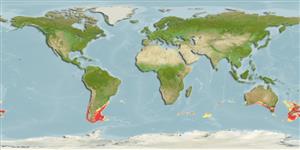Common names from other countries
Environment: milieu / climate zone / depth range / distribution range
Ecología
; rango de profundidad 5 - 1218 m (Ref. 87391). Deep-water; 31°S - 57°S, 76°W - 174°W
Southern Oceans: Known from southern South America (Argentina and Chile), New Zealand and Australia. Subtropical to polar.
Length at first maturity / Tamaño / Peso / Age
Maturity: Lm ? range ? - ? cm Max length : 7.5 cm TL macho / no sexado; (Ref. 101385)
Minimum depth from Ref. 78779.
Life cycle and mating behavior
Madurez | Reproducción | Puesta | Huevos | Fecundidad | Larva
Members of the order Decapoda are mostly gonochoric. Mating behavior: Precopulatory courtship ritual is common (through olfactory and tactile cues); usually indirect sperm transfer.
Macpherson, E. 2010. (Ref. 87468)
IUCN Red List Status (Ref. 130435: Version 2024-1)
CITES status (Ref. 108899)
Not Evaluated
Not Evaluated
Threat to humans
Harmless
Human uses
Pesquerías: comercial
FAO - pesquerías: landings | FishSource | Sea Around Us
Herramientas
Más información
Age/Size
Crecimiento
Length-weight
Length-length
Morfología
Larva
Abundancia
Fuentes de Internet
Estimates based on models
Preferred temperature
(Ref.
115969): 1.6 - 11.2, mean 6.6 (based on 365 cells).
Vulnerability
Low vulnerability (10 of 100).
